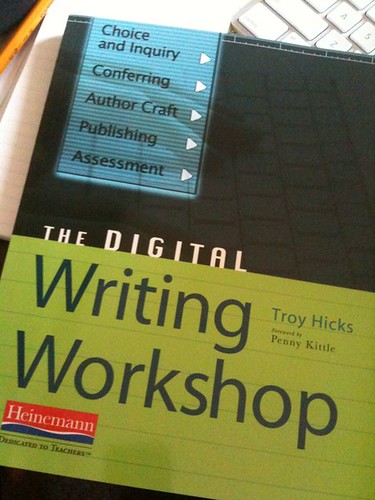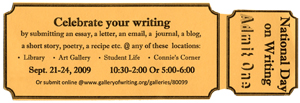It was a pretty amazing day here in Philly with the National Writing Project’s Digital Is Conference — we spent the entire day discussing, debating and considering the emerging digital literacy movement that we are seeing reflected in the lives of our children and students.
The morning began with an overview of why we were here — the rationale behind talking about the influx of digital media in our classrooms and why it is part of the writing focus. We then broke off into smaller groups. I took part in a discussion called Change Writers, which focused on a project that connected eighth graders with fourth graders in California to research social injustice, discuss the issues via blogs and then move into positive social action as a result. Much of our talk focused in on what the students did, with the teacher putting on emphasis on the fact that it was not the technological tools, but the ways those tools were used. In this case, the technology of blogs and voicethreads opened up a large audience for students who are often left out of the conversation because of socio-economic issues.
Here are a few things I heard:
“The technology is a piece of it. But it is not all about technology … Technology allowed us to take down the walls of the classroom. They were not just writing for me. They were writing for peers, for others, and getting feedback. The got to write without that ‘red pen’ slashing through everything. They could have conversations.” — Lesley McKillop, Prairie Elementary School.
“It’s not about the technology. It’s about using technology to help students join communities. They were no longer confined (to their classroom).” — Gail Desler, Area 3 Writing Project.
Later, I presented some student digital work — a digital science picture book — to a group and due to our protocols for discussion, I had to sit silently while the room talked about what they saw in the project, what “worked,” and what questions they had. Only then could I, the presenting teacher, grab the floor and put the project into context. It was a bit nerve-wracking, particularly when I saw former NWP Executive Director Richard Sterling sitting right in front of me with colleagues Charlie Moran and Anne Herrington. And across the room was Gail Hawisher. These folks are HUGE in the land of composition. But it was intriguing to “experience” the book through their eyes and lens.
A second afternoon session brought different folks together to talk about what they had learned and observed after viewing difference pieces of student work. I took a bunch of notes, but they would not make much sense to anyone (not even me at this point). But this Wordle nicely captures the main ideas from our discussion, which focused a lot on what we view as the new definition of Writing (not everyone agrees that this is new).

But we did have some important questions that we were left with from our table discussions:
• How do adults tackle issues affecting young people that the adults have not experienced themselves?
• What is relationship between traditional forms of writing and the new forms of writing?
• Keep an eye on the haves and have-nots – Will it exasperate the difference or equalize it?
• What is “writing” these days?
• What is missing from our conversations around digital literacy: questions about rhetoric and how it works and what you need to do it well.
• Are traditional composition classes the training ground for the new media literacy?
• Are new genres developing within new literacies that are irrelevant to the traditional writing classroom?
• How does the new design – non-linear text and media – affect our views of literacy?
• Do we even know what we should be teaching when it comes to new literacies?
• How does firewall affect teaching new literacies if every step in any direction is blocked?
• Some teachers are learning along with their students – they are learning by doing it.
Finally, I attended a session down the street at the Museum of Natural History, where various kiosks of student digital work — podcasts, movies, digital stories, etc. — were on display for viewing, and then I attended an interesting forum discussion about how young people are using digital media in their lives and how are educators meeting this shift (Mostly, we are not, to be honest).
So, long day with a lot to think about and ponder.
Peace (from Philly),
Kevin





